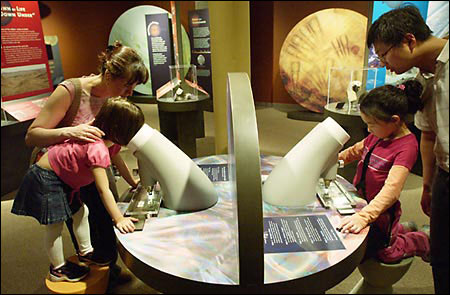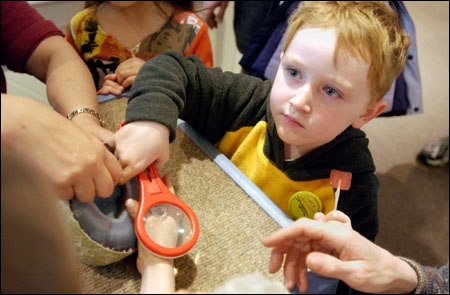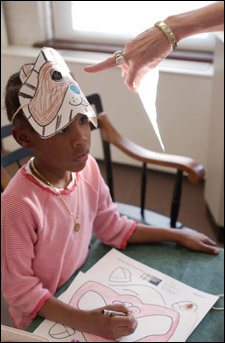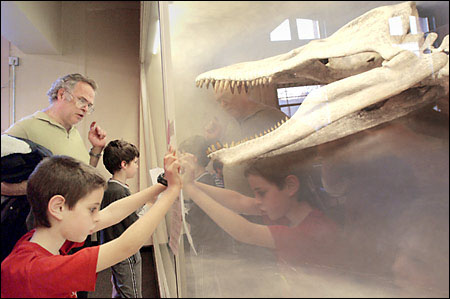The family that discovers together
Local families enjoy science night at HMNH

Ever been so close to a tarantula you can see the hair on its legs? Curious to know why some crystals grow large and others are like tiny jagged teeth? Wonder what a bee’s stinger looks like under a microscope?
Hundreds of Cambridge children and their parents explored these and other science mysteries at the Harvard Museum of Natural History’s first-ever Cambridge Family Science Night last Friday (April 8).
At a time when most buildings close up for the weekend, the museum was a magnet for inquisitive children, its halls buzzing with the sound of youthful discovery. Children were everywhere, peering at exhibits, chattering to each other, pulling their parents to tables where volunteer staff explained the science behind the natural wonders on display. Children touched the edges of crystals, compared the hardness of minerals by etching on plastic and glass, gaped at the hair of a tarantula under the microscope, and ran their fingers over dinosaur teeth.

For twin brothers Michael and Christopher Baker-Alberts, age 9, the Friday night visit was not the first. Michael was drawn to the museum to visit his favorite animal, the lemur, which stands in the museum’s animal collections. Christopher said he’d visited at least three times before, once when his King Open Elementary class came to learn more about minerals.

“We learned that there is iron in the scorpion’s shell,” said Christopher of the “Minerals Madness” class where he touched a live scorpion for the first time.
Jim Comeau, who was raised in Cambridge decades ago, remembered coming to the museum frequently as a child to visit the coelacanth. Holding the hand of his son, Jimmy, Comeau stood in front of the same 3-foot fish pointing out its feet and explaining how scientists thought it had been extinct for almost 70 million years until its deep-sea discovery in 1938.
A few feet away Jennifer Mekonnen, a fifth grader at Morse School, easily lifted a 2-foot-long dinosaur bone, then held a smooth rock that had helped grind up food in the stomach of a dinosaur millions of years ago. “I like science,” she said with a gleam in her eye.
The evening was a joint effort between Harvard and the Cambridge public schools. “Having our neighbors over for an evening is Harvard and the Harvard Museum of Natural History’s way of saying thank you for being our neighbors. It also gives people a glimpse of the partnership we have with the Cambridge public schools,” said Pete Money, education director for the Harvard Museum of Natural History. “We want people of all ages to see that science is alive and it’s fun.”

Deputy Superintendent of Cambridge Public Schools Carolyn Turk stopped by to thank Money for the museum’s efforts. “A lot of times people talk about a partnership, but often it’s only a partnership on paper. What Harvard has continued to do for us is truly a partnership. Together we have grown and learned how to come together on behalf of Cambridge families, children, and teachers.”
The Harvard Museum of Natural History hosted nearly 2,000 Cambridge children for science discovery classes last year, and the museum offers professional development courses for teachers and is adding new outreach programs next year. The museum is just one of several Harvard University science departments with ties to the local public schools. These programs are further supporting the Cambridge Public Schools Science Initiative and its goal of integrating science teaching in the schools with the broader community, including its colleges and universities.




